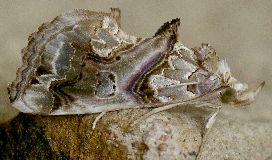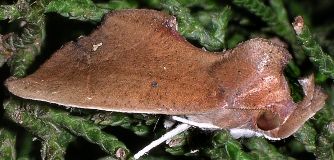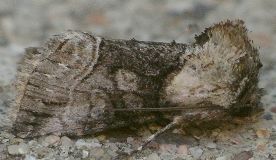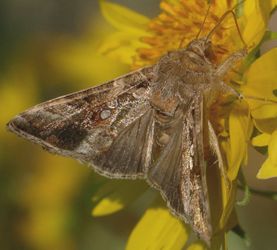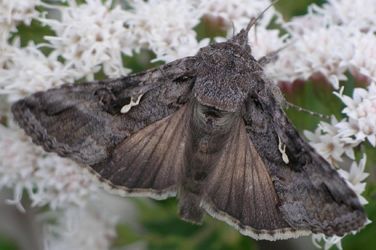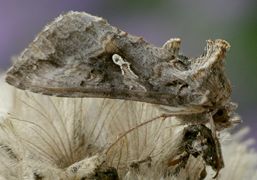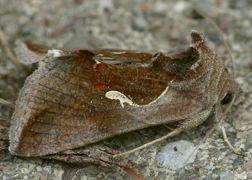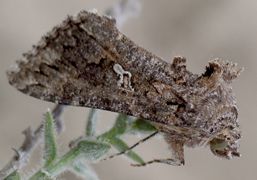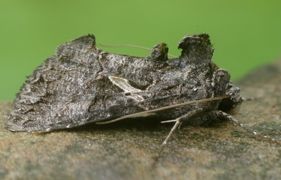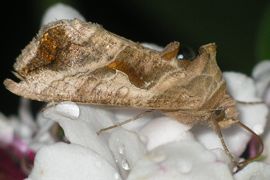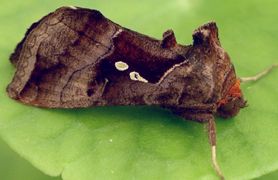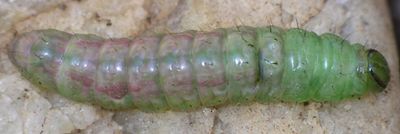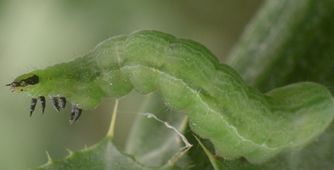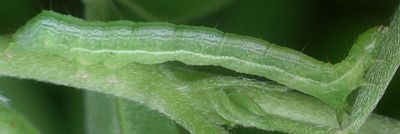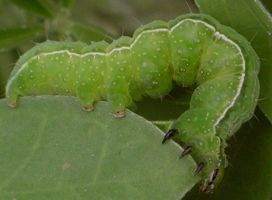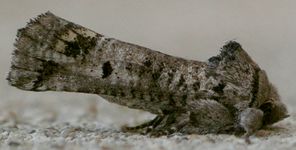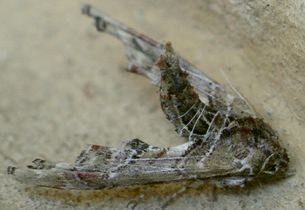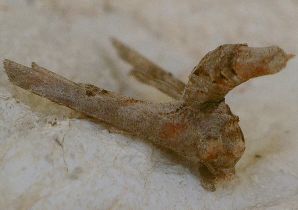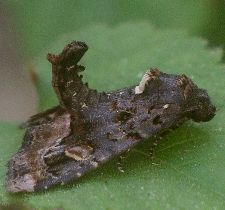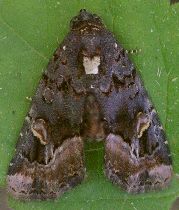
| Noctuidae ~ Owlet Moths |
page 1 ![]() page 2
page 2 ![]() page 3
page 3 ![]() page 4
page 4 ![]() page 5
page 5 ![]() page 6
page 6 ![]() page 7
page 7 ![]() page 8
page 8
|
A good number of noctuids have an irregular profile. These are best observed from the side instead of looking straight down at them from above. Perhaps none is more ornate than the Moonseed Moth (Plusiodonta compressipalpis), so named because its caterpillars feed on plants in the moonseed family. In our area, Carolina snailseed (Cocculus carolinus) is their preferred host. Not only is the 15 mm long moth a delightful mosaic of browns, purple and gold that looks more like a fragment of dead leaf than a moth, but the caterpillar (about 30 mm long) is an incredible bird-dropping mimic. This is a very common species in our area, present throughout the warm months.
Not nearly as common as the Moonseed Moth, Goniapteryx servia is larger (about 20 mm long) and a handsome reddish brown. There is a small white dot on each forewing, and the very enlarged labial palps make identification pretty easy.
The very hairy looking Abrostola microvalis reminds me of a prominent, with its shaggy mane. It is only about 12 mm long and moderately common. I've seen it in both spring and fall. A lot of the pest loopers (usually referred to as "green worms") that demolish veggies in our gardens produce attractive moths with profiles so irregular that they can rest right out in the open on a seed head or stem and not be noticed at all. They seem to be more numerous in the fall, and there are several species in this group that, as mentioned earlier, fly and feed during the day late in the year when the nights turn cold. Their wings often move so fast that they are just a blur.
Many of the looper moths have a shiny white mark on their forewing. This is called a stigma and, even though it might be slightly variable within a species, often helps in identification. The Gray Looper Moth (Rachiplusia ou) is one of the most numerous species of the group in our area. It is quite gray in color and is about 18 mm long. I not only find them on vegetation (they remain very still during the day when it is warm) but also around outdoor lights where they were obviously attracted the previous night. The Soybean Looper Moth (Chrysodeixis includens) is another common species. They are a bit variable, sometimes much darker than the one pictured here, but the markings usually match up. The stigma is split into two distinct spots. Size is a bit small at 15 mm. Easily recognized by the large shiny stigma, the Bilobed Looper (Megalographa biloba) is sometimes very common during the cooler months. It is about 17 mm long. The Celery Looper Moth (Anagrapha falcifera) is reported for our area but I've not yet seen one here. It is common in other places, though, and the accompanying photo was taken in Wisconsin. It is about the same size as the Gray Looper; the stigma shape is distinctive. I've only seen Autoplusia egena once, so it may be less common than some other loopers. It is rather metallic, small (13 mm long), and has such a thin stigma that it is almost invisible.
The Pink-washed Looper Moth (Enigmogramma basigera) most likely gets its name from the pinkish color on the blobby green caterpillar. The 15 mm long adult has a smooth velvety texture and an orange collar behind its head. I've actually seen the caterpillar more often than the adult. While many green looper caterpillars are difficult to ID accurately, this one is not. The Cabbage Looper Moth (Trichoplusia ni) is a little bigger (17 mm) and is very rough in texture. It reminds me of carpeting. Remember that I mentioned the stigma (white spot on wing)? Well, its shape is main characteristic of the Sharp-stigma Looper Moth (Ctenoplusia oxygramma). This looper moth is rather similar to the Cabbage Looper Moth and even the Gray Looper Moth, but that stigma will help a lot with the ID.
With a bit of practice, it is possible to sort out adults fairly consistently. The larvae are another matter. While the Pink-washed Looper (Enigmogramma basigera) is distinctive, at least when it is almost ready to pupate, the other loopers are not nearly so distinct. I find several that I simply cannot figure out to species, or even genus, as all these similar moths are in different genera. As the caterpillars grow, they tend to get fatter as well, so consider body shape to be variable. The things to look for are details, such as head capsule markings or specific lines or lack thereof on the body. I've not yet mastered the use of setae (hairs) or other extremely tiny characters for identification. The loopers tend to have translucent green bodies with light stripes punctuated with small white circles on their backs. They have a few sparse hairs and 3 pairs of prolegs at the rear. They usually have a white line down the side and may also have black associated with that. The head capsule is green and may also have a black line on each side, sometimes edged with white. These larvae eat a wide variety of plants, so host information seems of limited use. Here are the larvae that I THINK I've figured out: The Bilobed Looper has a very thick black line on each side of its head. There is a very similar caterpillar that has a black AND WHITE line instead; I don't know what this one is. The Soybean Looper is one of the most common. It can have a few black dots on both the body and head, but often doesn't. It might not have a black line on the side of the head but if it does, it is quite thin and low (not visible from above). There is a similar caterpillar with a much thicker white side line, which has me stumped. The Cabbage Looper looks very similar to the Soybean Looper but doesn't have any black dots or black on the head. The white lateral line fades out before it reaches the back end. I do not have very high confidence in my conclusions and am still working on figuring these out.
There are some noctuids with very odd postures. One that is really confusing is Aon noctuiformis. This 15 mm long moth rests with its wings rolled around its body, much like some prominents. It can be outrageously common at times, especially in the spring. It is slightly variable in color.
Some moths do not even look like moths! The marathyssas are such creatures. There are two, and their names don't seem to have anything to do with their looks. I have seen each only once, so I do not think they are particularly common. These moths rest with their wings sort of folded up like a fan to make them thinner and then held out at almost an 90° angle. They curl their butt up in the air while their nose touches the ground (a posture shared with some geometrids, pyralids, and crambids). Coloring is quite variable. The Light Marathyssa (Marathyssa basalis) can be distinguished from the Dark Marathyssa (Marathyssa inficita) mainly by the presence of thin white lines on the body and wings. In my extremely limited sample, the Light Marathyssa was actually darker than the Dark Marathyssa. It also did not tip its rear end quite as far forward, but this may just be an expression of individual preference on the moths' part.
Another "butt in the air" moth is the Large Paectes (Paectes abrostoloides). I've not found this species in our area but it should be around as I've heard reports of caterpillars. The photo was taken in Dallas during September.
One more noctuid that raises its rear is the Black Wedge-spot (Homophobera apicosa), with wings about 13 mm in length. This is another uncommon species that is, however, easily recognizable by its attractive dark color and obvious white spot. |
page 1 ![]() page 2
page 2 ![]() page 3
page 3 ![]() page 4
page 4 ![]() page 5
page 5 ![]() page 6
page 6 ![]() page 7
page 7 ![]() page 8
page 8
![]()
